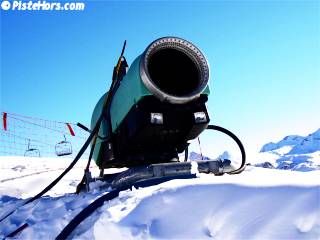Interesting post!
Yeah, It will be a fine and exciting tourism play.
The Swiss Federal Institute for Snow and Avalanche Research located in Davos have just released a monster 189 page tome in German studying the effects of snow canons on the mountain economy. I’ve only had time to read the “shorter” 35 page version. The overall conclusion is that while artificial snow is essential in the short term for the economic stability of ski areas long term it has no future below 1500 meters.

Last winter was a serious challenge for ski resorts in Europe as snows failed to arrive before mid-February. The last time this had happened in France was the winter of 1989-90. That year ski resorts suffered serious economic hardship with a drop of 30% in turnover forcing a number into bankruptcy. Even big, high altitude resorts like les Arcs had to be virtually nationalized under the auspices of the Compagnie des Alpes, a subsidary of the French state investment bank. Last season also saw difficult times but the drop in turnover was restricted to 10% overall with some resorts such as Val Thorens and Chamonix actually increasing profits. Artifical snow cover was a key element in last year’s better results.
The Swiss study is titled “Climate change and winter tourism: Economic and ecological effects of artificial snow production”. It analyses the relevance of snow production for ski areas the the surrounding economy, resource consumption (water, energy) and the environment. In Switzerland, artificial snow is used on 19% of the total ski piste area, the figure is similar for France. Austria has already reached the level of 50% and in some areas in the Italian Alps artificial snow is used on all the ski runs.
The Swiss weather service has said that while global average temperatures increased by 0.6 °C during the 20th century the rate for the Northern Alps was between 1.3 °C and 1.6 °C. Current scenarios predict a further increase of 1°C by 2030 and +1.8°C by 2050. The report notes that cover at elevations below 1,300 meters have already significantly decreased since 1980 and at high altitudes there is less snow in the late Autumn, a period essential for the start of the ski season.
The report takes Davos as an example. Tourism contributes 40% to the local economy with winter sports at 26% forming the majority. Ski lifts contribute 5% to the economy. The report suggests that artificial snow cover could prevent losses of up to 10% of aggregate income for the community of Davos in winters with poor snow. Interviews with tourists show that while winter sports enthusiasts accept snow making and they are a factor in choice of destination summer visitors have a negative attitude to the installations. However resistance has decreased in all groups. Not surprisingly locals see snow making as a key factor in the economy although they recognise the need to diversify away from a model based purely on downhill skiing.
In Davos snowmaking represents 0.5% of total energy consumption for the community (cf Oil Price Will Hit Ski Resorts Hard). Residential use is 32.5%. Water consumption is considerable, between 20 to 35% of regional water consumption. The report found that the affects of man made on fauna and flora differed significantly between regions and elevations. In particular it should be avoided on low soil nutrient areas. A separate study by the Mountain Institute of the University of Chambery shows that 30% of water used for snow making is lost to the water cycle and that artificial snow, being denser, causes faster run-off when snows melt or if there is rain.
The study showed that a normal ski season, defined as 100 days of snow cover greater than 30cm, was no longer reliable at altitude of 1200 meters and this would increase to 1500 meters by 2050. The report claims that snowmaking will not be viable at 1200 meters by 2030. It suggests resorts build transport to take skiers to higher parts of their areas at the start and end of season. Resorts will also need to play to regional strengths and offer high quality none-ski activities. Resorts will need to take account of these factors before expanding snow making.
http://www.wsl.ch/forschung/forschungsprojekte/klimawandel_wintertourismus/index_DE?-C=&
Southern alps ski resorts ready for winter
Ecologists target snow canons
Ex-minister takes aim at snow canons
Les Arcs doubles snow making
Interesting post!
Yeah, It will be a fine and exciting tourism play.